Some New Insights and a Note Regarding Alexander Jannaeus Anchor/Star (TJC Group L) Coins
Abstract:
The article examines one specific type of
coin that was minted by Alexander Jannaeus and probably by his
successors, during the first century BCE. New variants and
unpublished specimens are discussed along with a proposal that
this coin type may be divided into four subtypes. The article
also considers the preparation of the dies used to mint the
smallest of this type of coin. Finally, the article proposes the
denomination that these coins had in the ancient Judean
marketplace.
Key Words:
Alexander Jannaeus http://d-nb.info/gnd/1048422461,
Judea
https://pleiades.stoa.org/places/687934, 1st century BCE –
1st century CE, Khirbet el-Maqatir http://d-nb.info/gnd/1151919179
Zusammenfassung:
Dieser Artikel untersucht einen spezifischen Münztyp, der von
Alexander Jannaeus und wahrscheinlich von seinen Nachfolgern im
1. Jh. v. Chr. geprägt wurde. Neue Varianten und unpublizierte
Exemplare werden diskutiert, einhergehend mit dem Vorschlag,
diesen Münztyp in vier Untertypen aufzu gliedern. Daneben wird
die Herstellung der Stempel berücksichtigt, mit denen die
kleinsten Exemplare dieses Typs geprägt wurden. Schließlich
machen die Autoren einen Vorschlag, welches Nominal diese Münzen
im judäischen Zahlungsverkehr einnahmen.
Schlagwörter:
Alexander Jannaeus, Judäa, 1. Jh. v. Chr. – 1. Jh. n. Chr.,
Khirbet el-Maqatir
The most common Jewish
coin in the archaeological record in Israel is a small bronze
coin minted by Alexander Jannaeus and likely by his successors
as well. Ya‘akov Meshorer in his »A Treasury of Jewish
Coins« (below cited with the common abbreviation TJC)
labels this type as group L with seventeen variants[1],
although there are apparently many dozens more. The obverse of
this type has an anchor surrounded by a circle; around the
circle is a Greek legend, on many of the coins imitative. The
reverse has an eight or six-ray star surrounded by a border of
dots; around the border is an Aramaic legend, on many of the
coins imitative. TJC L is also the only group of
Alexander Jannaeus coins that has a date (»year 25« = 79/8 BCE).
Since the publication of
TJC, more than twenty years ago, an abundance of
new data is available that facilitates an affirmation and a fine
tuning of Meshorer’s conclusions. In this essay we seek to offer
a few insights on the TJC group L coins: 1) There
are two new variants of a star, now with five and seven rays. 2)
We propose that scholars discuss the TJC group L
coins in terms of four subgroups instead of identifying an ever
growing list of variants. 3) We present an unpublished and
interesting variant which proves that some dies were
intentionally made with a partial star image. 4) We propose that
two of our subgroups were intentionally struck on small and
irregular flans by Jannaeus successors to serve as half-prutah
coins.
Insight No. 1: Two new variants – five
and seven ray stars
Two new variants in the depiction of the star for the TJC group L coins were recently discovered. The first variant depicts a star with five rays; one specimen of this type was discovered at Khirbet el-Maqatir[2] (0.61g, 5x7mm; fig. 1)[3] and a second is from a private collection (0.57g, 10x12.5mm; fig. 2)[4].
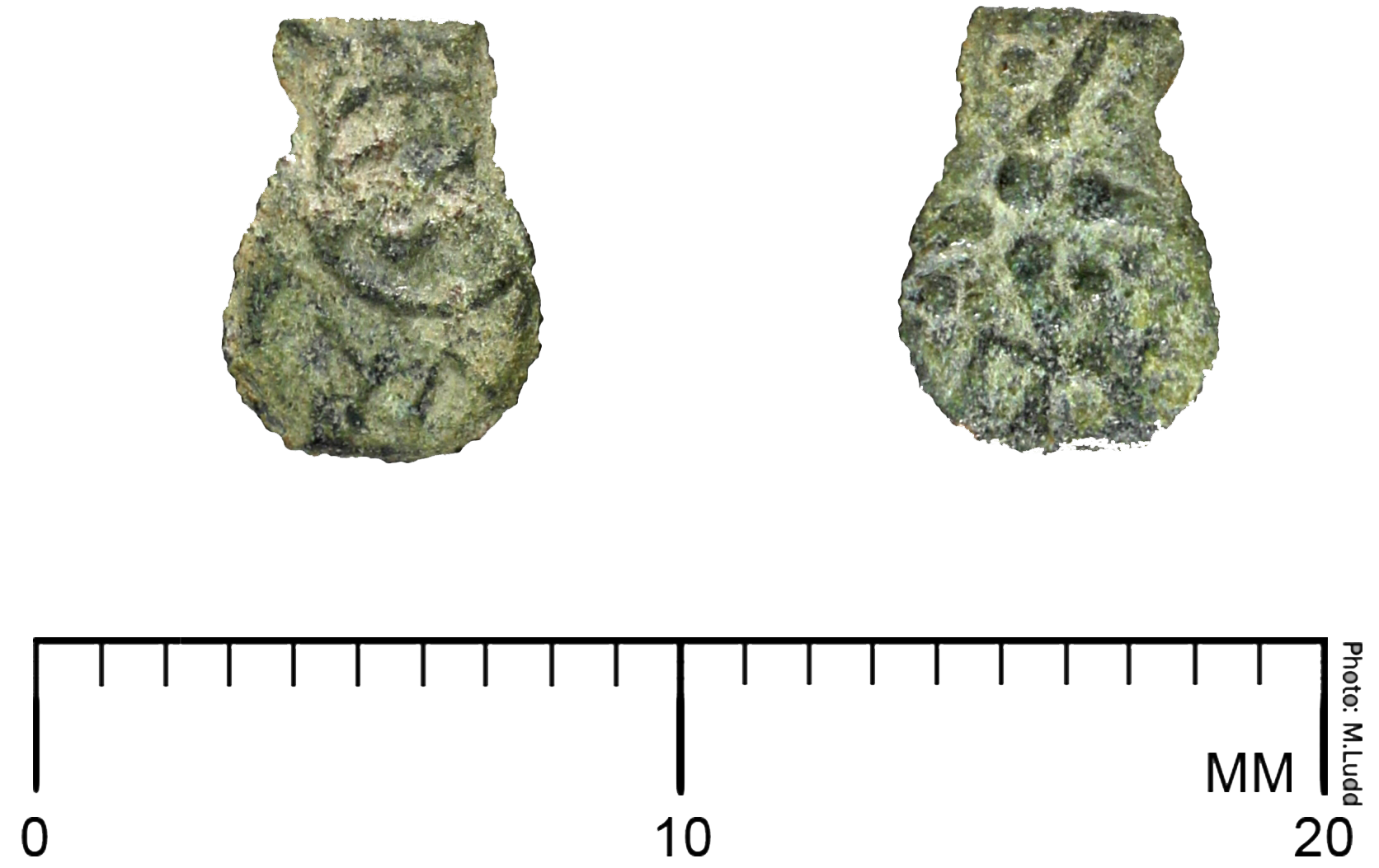
Fig. 1: From Kh. el-Maqatir, No. K041199
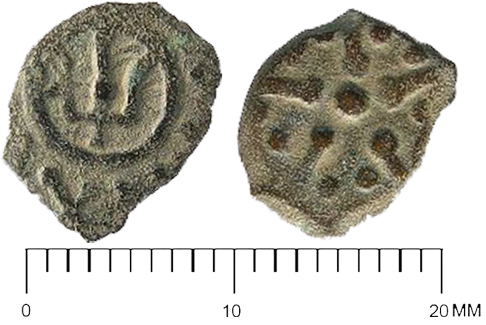
The second new variant
depicts a star with seven rays. The excavations at Khirbet
el-Maqatir produced two such coins (figs. 3 and 4). These
two coins were initially identified and discussed in the final
excavation report for Khirbet el-Maqatir[5].
Even though two different dies produced the coins with seven
rays, we are of the opinion that this is nothing more than an
anomaly resulting from poor craftsmanship in the making of the
dies. If a seven-ray star, or even a five-ray star, was
intentional we would expect that many more coins with five or
seven rays would have been found throughout Israel.
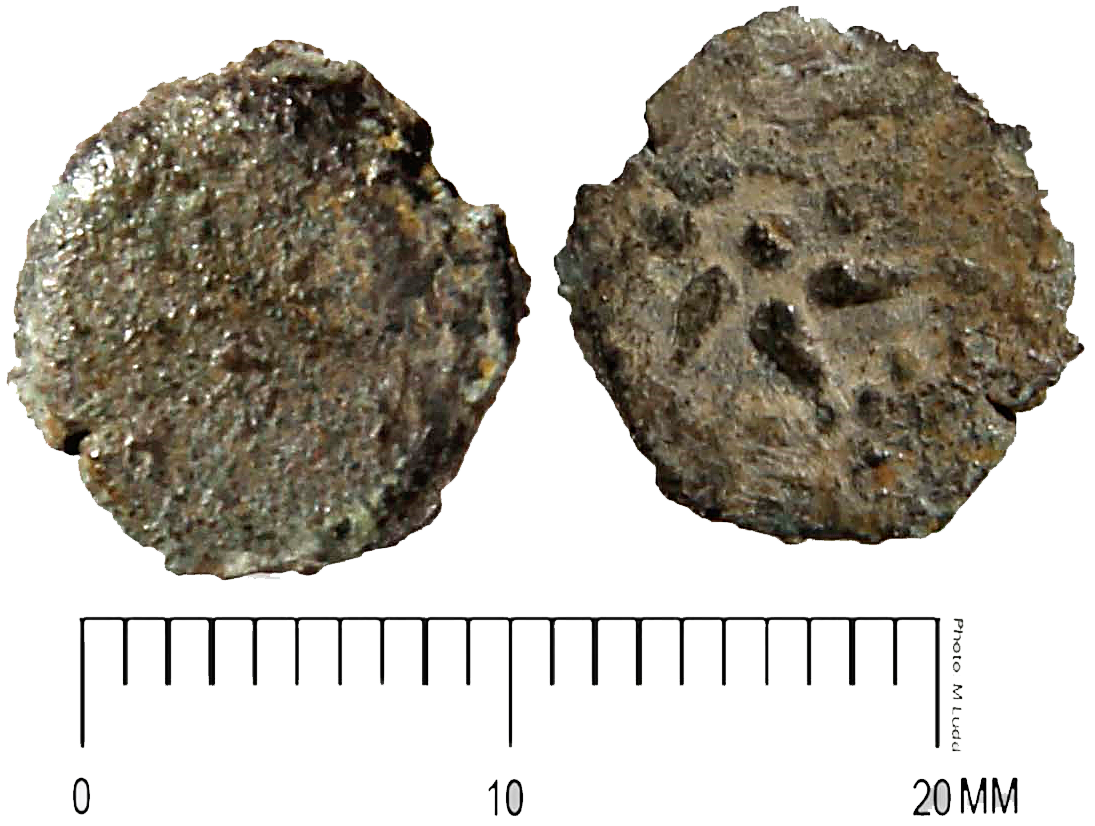
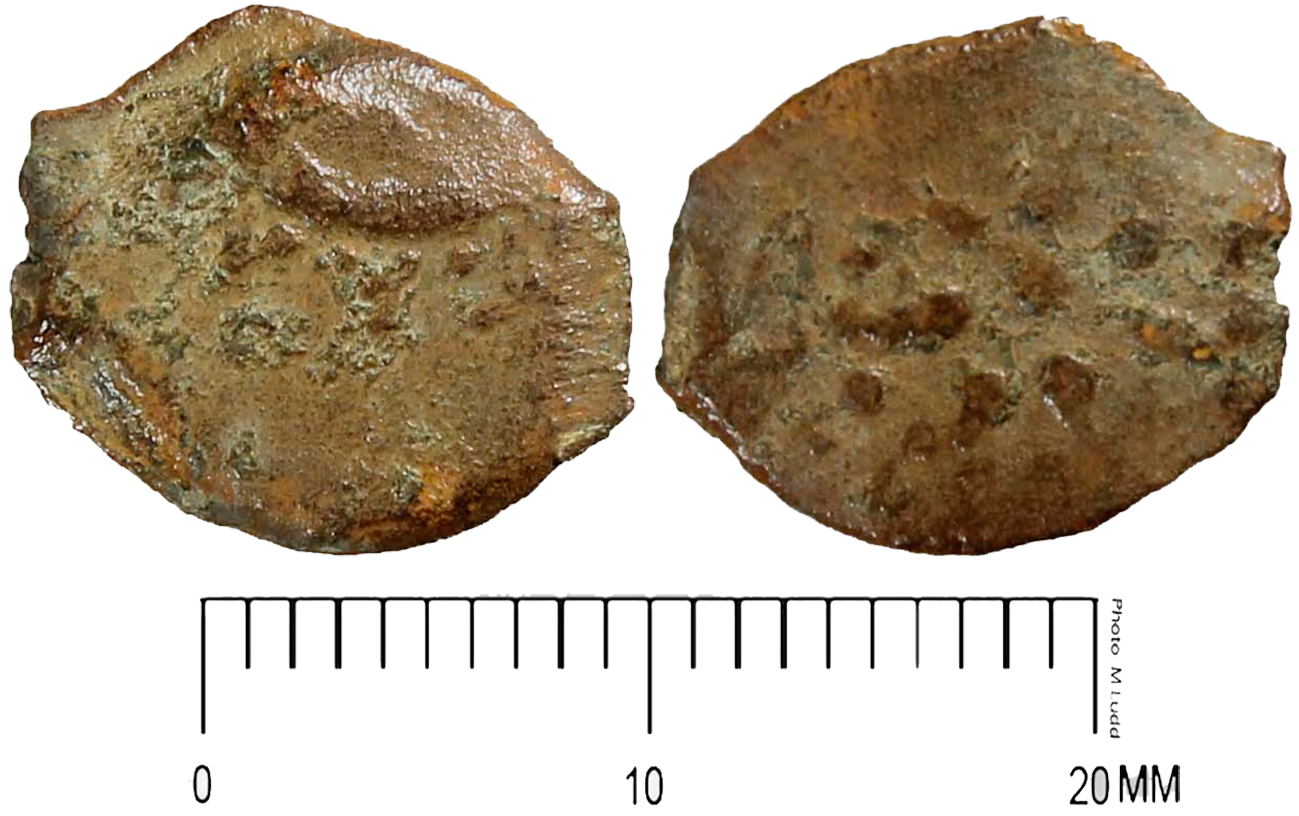
Fig. 4: From Kh. el-Maqatir, No. K045186
Insight No. 2: The TJC group L coins may
be divided into at least four subgroups
As stated above,
Meshorer’s standard reference for ancient Jewish coins, »A
Treasury of Jewish Coins«, classifies coins into major
types along with many variants of those types. For the group L
coins Meshorer lists seventeen different variants[6].
They show such things as: variations in spelling, missing
letters, variations in the number of rays of the star, parts of
link pieces still attached to the flan, rays of the star
represented by dots, legends missing on the flan because the
smallness of the flan, and several other factors. While there is
value in identifying variants, with each new coin that is
discovered there is the likelihood of the list becoming longer.
While this is not a concern in and of itself, when it comes to
discussing the coins, numismatists have tended to group variants
into groups. For example, over the past twenty years, for
purposes of discussing the TJC group L coins,
numismatists have tended to group together L1–6 and L7–17[7].
The rationale for this division may lie in TJC’s
description of the variants. Beginning at L7 Meshorer uses the
adjective »crude« and this then defines the remaining variants.
Having examined hundreds of TJC group L coins we
think that there are at least four main subgroups, rather than
two.
Subgroup L-I (fig. 5):
Designates coins whose flan is of sufficient size to accommodate
the legend on the outer edge of each side of the coin. The star
is depicted as having eight rays. These coins are the largest
and heaviest in this series (mean weight 1.27g and ranging
12–16mm in diameter)[8].
Most of the TJC group L1–3 coins would fall into
this subgroup. Likely a development of the Alexander Jannaeus’s
TJC group K coins, we consider this subgroup the
principle issue of group L.
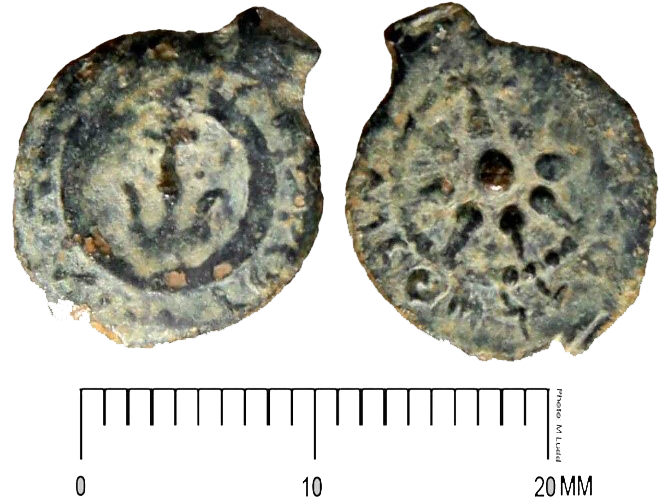
Subgroup L-II (fig. 6): Designates coins whose flan is slightly smaller and results in the legend on one or both sides of the coin to be significantly missing. The star is depicted as having eight rays and they are slightly smaller than L-I subgroup (mean weight 0.84g and ranging 8.5–15mm in diameter). Often the star is struck with more than 50% of it missing. Most of the TJC group L4–7 coins would fall into this subgroup. We consider this subgroup a contemporaneous less careful issue of group L-I, serving as the same denomination.
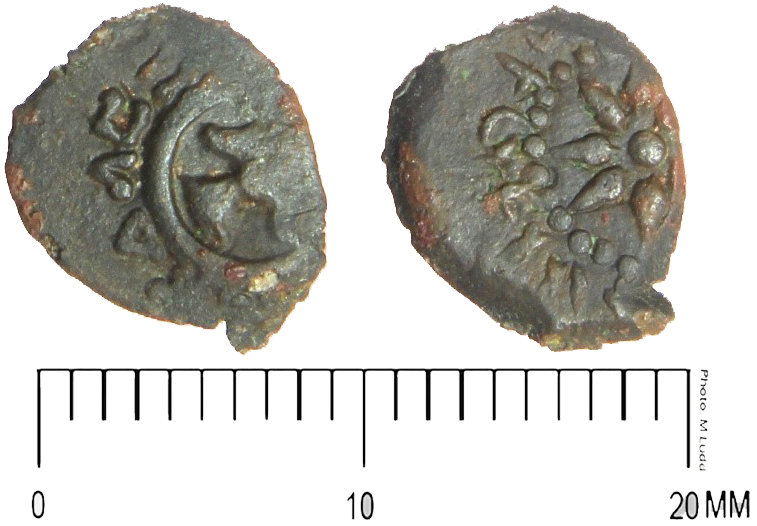
Fig. 6: From Kh. el-Maqatir, No. K044747
Subgroup L-III (fig. 7): Designates coins with smaller flans and the star is depicted as having six rays with the Aramaic legend, which includes Alexander Jannaeus’s name and the date »year 25«, removed. The size of the flan continues to shrink with the mean weight ~0.52g and the diameter ranging 7–14.5mm. Most of the TJC group L8–13 coins fall into this subgroup.
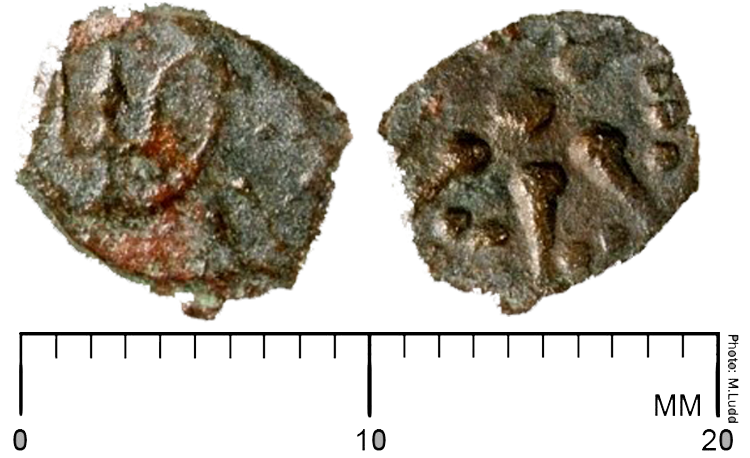
Fig. 7: From Kh. el-Maqatir, No. K041327
Subgroup L-IV (fig.
8): Designates coins that have the anchor hardly seen on one
side and just one or two rays of a star and dots that are linear
rather than forming a circle (one can also see an example in
TJC L14). This subgroup is not just an even poorer
striking from an eight or six-ray die, as if the image is
accounted for by the die being off center to the flan. The eight
or six-ray die has the dots that make up the border circle at
the outer end of the rays. This particular die places dots
parallel to the ray, even down at the base of the ray. If it was
a regular die used on a very small flan we probably would not
see any dots on the star side. Additionally, we project that if
a die used to strike the star was a complete image (like the L-I
coins), that die would be at least 20 mm in diameter. This is
too large given the flan size. Therefore, the die was
intentionally made with just one ray and did not include a
complete star with a doted circle and legend around it (see
further discussion below, Insight 4). These flans are the
smallest in the L group, with a mean weight of just ~0.29g and a
diameter that ranges 5.5–12mm.
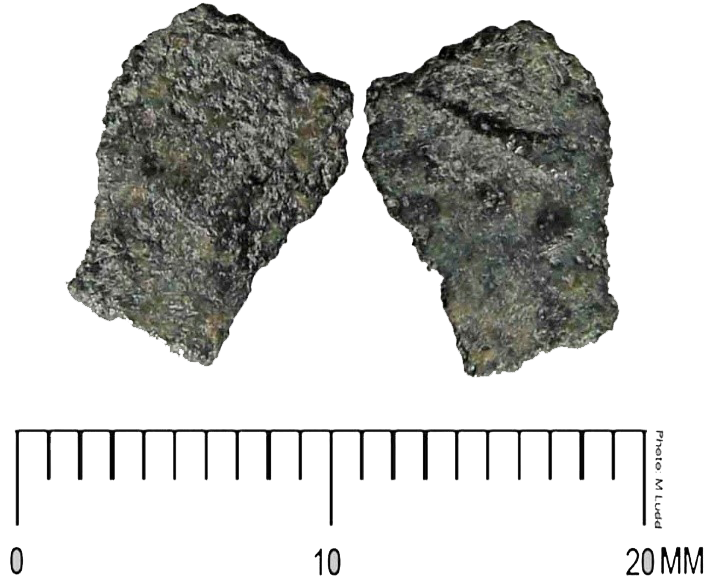
Fig. 8: From Kh. el-Maqatir, No. K045115
Insight No. 3: Some dies were
intentionally made with a partial star image
The following unpublished coin is from a private collection (0.5g, 9x10mm; fig. 9)[9]. The side of the star has two rays only, with two dots in between them and two square blundered imitations of Aramaic letters, which look like the Greek letter Π (pi). The other side has 3/4 of the anchor within a plain circle and some Greek letters around it, of which only the letter Λ (either lambda or alpha) is clearly visible.
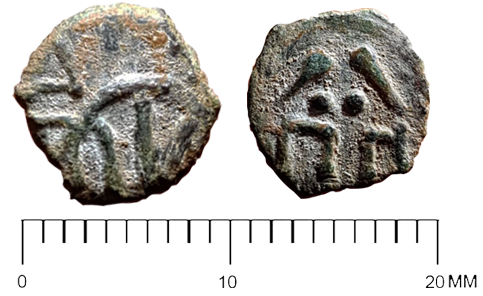
Fig. 9: Ziv Zur collection (photo by Ziv Zur)
To assist in analyzing this unique coin, we placed the coin next to another TJC group L coin (fig. 10). Both coins are similar in size with the bottom coin being just 1mm larger (9.5 x 11 mm). The proportion of the anchor that is visible and space for the corresponding legend beyond the circle of the anchor is consistent between both coins. The coin from the private collection is thick enough to have a beveled edge visible on the anchor side; unlike the bottom coin which is too thin for a bevel. The imitation Aramaic lettering underneath the rays of the star are in a straight line; unlike the legend that curves around the dots that circle the star on other TJC group L coins. In addition, a close examination of the coin reveals what seems as a plain circle (in low relief) above the two rays, not part of the engraving of the die, but perhaps the physical edge of the die (see fig. 11).
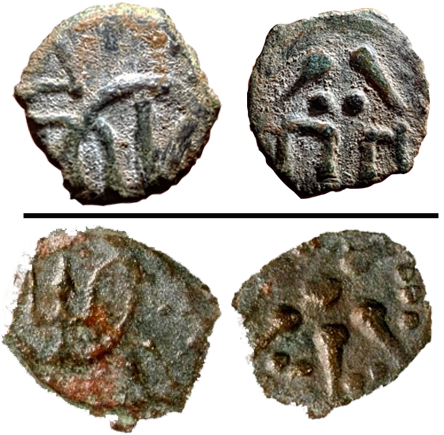
Fig. 10: Ziv Zur coin on top; TJC group L coin on bottom from Kh. el-Maqatir, No. K041327
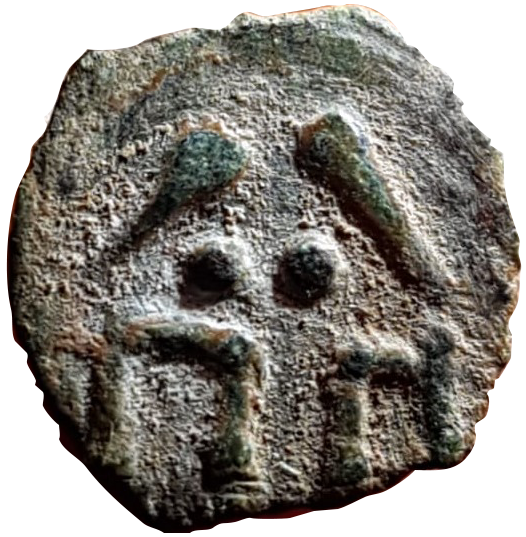
Fig. 11: The possible edge of the die above the rays
Generally, it seems that
the dies which were used for the crude types of TJC
L (our groups III–IV) are usually one and a half to two times
larger than the image actually struck on a coin. The size of
this coin (9x10mm) and the size of the designs suggests that in
this case the die used for the anchor was ~16mm and the die used
for the star was ~10mm[10].
The die used for the anchor is clearly too large for the flan.
But for the star, what we see on the coin is evidence that at
least in this case the die was intentionally made to not include
a complete design of a star with six or eight rays and a
complete legend around it, but only part of the whole design was
included in the die. Likewise, one should note that no such
possible frame can be seen around the design on the anchor side,
supporting the position that a larger die was used to strike
that side. This partial star die, which includes part of the
star (two rays), part of the surrounding dotted circle (two
dots) and part of the surrounding legend (two letters), was good
enough to represent the whole design in order that it could be
identified by the person who would use it.
In reviewing the coins from Khirbet el-Maqatir we discovered an interesting parallel to this coin. The five-ray star coin from Khirbet el-Maqatir (fig. 1) is similar in weight to the coin from the private collection (0.61g compared to 0.5g), but it is one-third the size (5x7mm compared to 9mm). As already mentioned the star is depicted with five rays, unusual for these Alexander Jannaeus coins since they are typically six or eight rays. But the most curious feature is the spacing of the rays, the two dots between the rays, and the surviving letters underneath the rays (fig. 12). A die-link is not possible for these two coins due to the difference in size. Likewise, there is nothing on the Khirbet el-Maqatir coin that could account for the possible mark from the edge of the die above the rays as appears on the coin from the private collection (fig. 11). Nevertheless, we suggest that the inspiration for the die that was used for the two-ray coin comes from imitating part of a five-ray star with dots and letters.
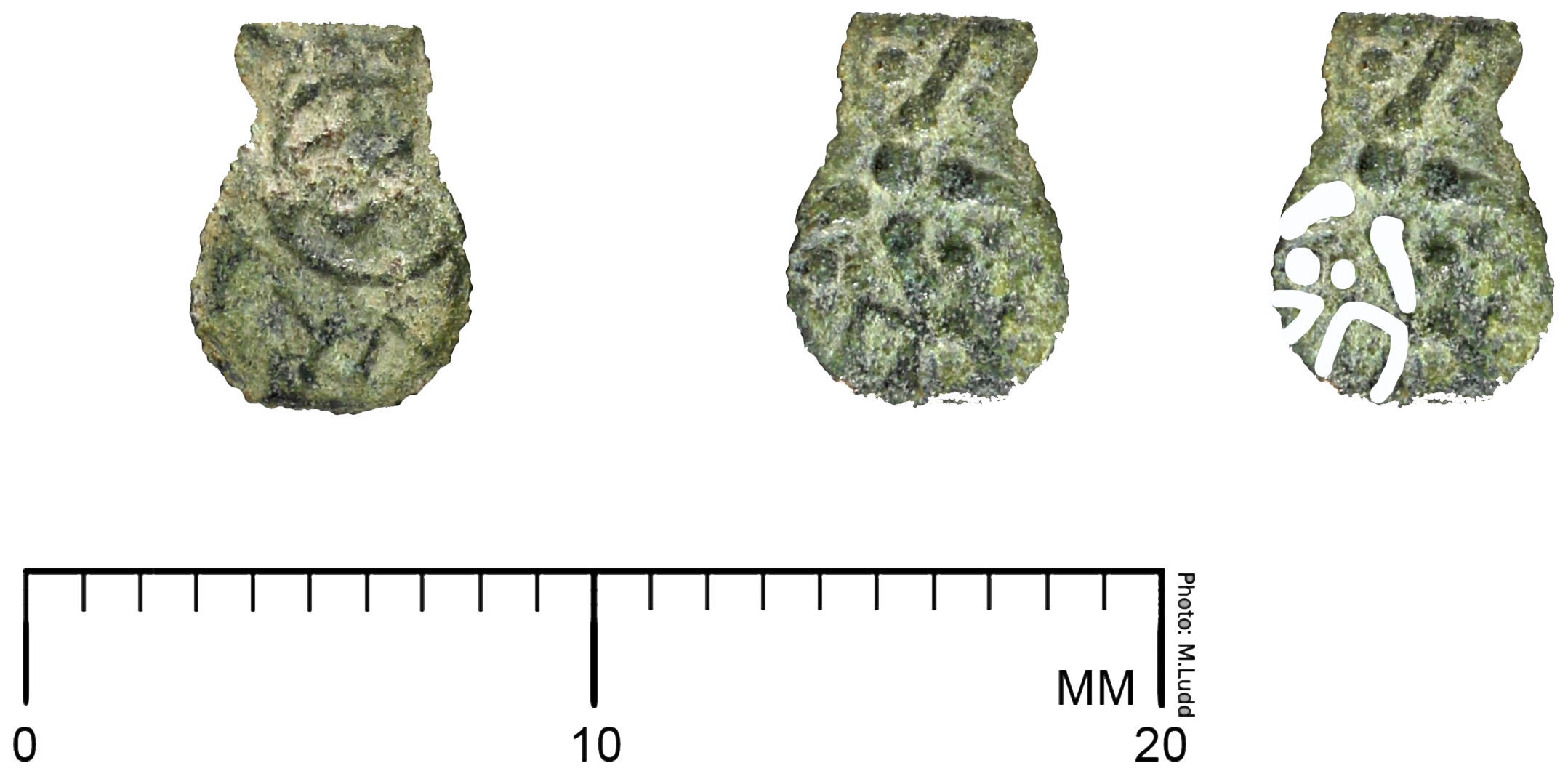
Fig. 12: From Kh. el-Maqatir, No. K041199 with rays, dots, and lettering similar to the coin in fig. 9
Using our proposed
sub-types, Insight 2 (above), we would place this coin from the
private collection alongside the L-IV subgroup. This grouping is
justified for two reasons. First, the commonality of a small
flan. Second, the image of a star struck by a die that was
intentionally made with a partial star image.
If we are correct in our
basic understanding of this coin, then there is a significant
implication that leads to our final insight – that groups L-III
and L-IV were intentionally struck on small and irregular flans
to serve as half-prutah coins, likely by Jannaeus’s
successors.
Insight No. 4: Groups L-III and L-IV were
intentionally struck on small and irregular flans to serve as
half-prutah coins, possibly by Jannaeus's successors
Numismatists have long
acknowledged the difficulty in naming and assigning
denominational value to Judean bronze coins. Citing Arie Kindler[11],
David Hendin affirms that the Judean bronze coins are most
properly called prutot (sg. prutah) and half-prutot
(also called a lepton in Greek)[12].
In his study of the metrology of these small bronze coins Hendin
confirms the view of Meshorer that the denominations are not
distinguished by weight. Rather, one distinguishes the
denominations by the design of the coin[13].
Hendin makes the following conclusions about the denominations
of some of the Judean small bronze coins:
1)
The irregular TJC group L coins are degraded
prutot and not half-prutah coins. Hendin says that
Alexander Jannaeus did produce a half-prutah coin as
evidenced in the coin’s different design but they are very
scarce[14].
Hendin probably meant TJC group O coins, although
he did not state this.
2)
Mattathias Antigonus did not mint half-prutot[15]
3)
Herod I did mint half-prutot but they have proved to be
quite rare in the archaeological record[16]
4)
Herod Archelaus minted a half-prutot[17]
5)
Hendin does not identify anyone else who minted Judean bronze
coins of the half-prutah denomination.
Accepting the conclusion
that the design and diameter is the key to distinguishing the
denomination (in most cases regarding bronze coins), our
proposal is that the L-II subgroup was minted contemporaneous to
L-I subgroup or in subsequent years but prior to Alexander
Jannaeus’s death. The smaller flan that was used for the L-II
subgroup may have been necessitated by the population’s need for
prutot given the large geographical expansion of
Jannaeus’s kingdom. The smaller flans allowed for more coins to
be minted from the same amount of metal.
We also propose that the
L-III and L-IV subgroups were minted after Alexander Jannaeus’s
reign and that they, along with the L-II already in circulation,
were used as half-prutah coins by the time of the first
century CE[18].
This proposal takes into account three considerations: the
change in the dimensions (weight and diameter) and shape of the
flans (from round flans to more oval or elongated); the design
of the TJC group L coins, from a star with eight
rays to one with six to one with two or fewer rays; and the
historical reality of a lack of half-prutot in the first
century CE, along with the high frequency of L-II, L-III, and
L-IV coins recovered in first century CE contexts (see Table 1
for a summary)[19].
Table 1: Suggested
denominational usage of TJC
group L coins
|
Group L |
During
Alexander Jannaeus’s Lifetime |
Mid 1st
century BCE |
By late 1st
century BCE |
|
L-I |
Prutah |
Prutah |
Half-prutah
|
|
L-II |
Prutah |
Prutah |
Half-prutah
|
|
L-III |
|
Prutah
or half-prutah (?) |
Half-prutah
|
|
L-IV |
|
Half-prutah
|
Half-prutah
|
There are two
distinguishing characteristics between the L-II and L-III types,
regarding the dies presenting the star. The first is the change
from an eight-ray star to a six-ray star. The second is the
removal of the Aramaic legend which includes Alexander
Jannaeus’s name and the date »year 25«. We think it is
reasonable that these two changes are an acknowledgement on the
part of the engravers that these coins are not ›real‹ Alexander
Jannaeus coins. Thus these coins were minted after the death of
Alexander Jannaeus. We think it is most reasonable to assert
that the striking of the L-III coins occurred in the mid-first
century BCE. Whether the L-III types were intended to be
prutot or half-prutot remains undetermined. Hendin
believes that the intent of these coins was to be prutot,
especially when initially struck in the mid-first century BCE[20].
We have no firm objections to this conclusion. However, we do
not wish to rule out the possibility that the L-III coins were
minted after Alexander Jannaeus reign to serve as half-prutot
while the L-I and L-II continued to be used by the
population as prutot (along with all the other types of
Alexander Jannaeus’s coins; see more below).
As for the L-IV coins,
these coins are the most difficult to understand. Part of the
difficulty in understanding this proposed subgroup is that these
coins are usually not collected in excavations that do not use
metal detection; consequently, they do not appear in reports. As
we commented above, the dies used to make these coins appear to
be purposeful. Perhaps the creation of a one-ray or two-ray star
die was nothing more than an aesthetic gesture since the flans
had become so small. Such a die ensured that at least one or two
rays would be visible instead of the potential for no rays to be
visible with the use of a larger die on such a small flan. When
the L-IV coins were struck and their denominational value are a
great enigma. Whatever one concludes about the date of striking
and the denominational value of the L-III coins likely applies
to the L-IV coins[21].
In any case it is hard to believe that the denominational value
of the L-IV coins, which are the tiniest and the most crude of
this type, was intended to be the same as L-I–III coins, thus
they were most probably struck in order to serve as half-prutot.
Regardless of the
original denominational value of the L-III and L-IV coins, we
believe that by the late first century BCE and first century CE
these coins were used as half-prutot[22].
There are two main reasons for our suggestion. First, while the
ruling authorities (i.e., the Herodians and the Roman governors)
are producing prutot in the late first century BCE and
first century CE, there was a lack of production of half-prutot
in this period and especially during the first century CE. As
mentioned above, no one has suggested that half-prutot
were minted after Archelaus. Second, the archaeological data
shows the frequency of the TJC group L coins found
in first century CE contexts[23].
In the first century CE people are clearly using the TJC
group L coins, and thus it seems that there was a need for these
coins, probably as half-prutot[24].
If the ruling authorities are not producing enough of this small
change then the people are meeting their need by continuing to
use the Alexander Jannaeus TJC group L coins more
than a century after they were struck or by the (tolerated?,
unauthorized?) minting of some of these coins during the first
century CE.
A Note regarding the production technique
of TJC L coins
In 1922 Hill discussed
the ancient methods of coining. One of his insights was that
a very common fault, especially in small
coins, was caused by the dies being badly registered, so that
only part of the type of one side was struck on the blank, the
greater part of the blank being left empty. This faulty
adjustment, in the case of blanks cast en chapelet and
not separated before striking, but placed on an anvil in which
several obverse dies were set, would produce coins with
impression of parts of two different dies on the same side. The
blank was evidently placed so as to lie partly on two obverse
dies, and the reverse die was brought down on it; thus a
complete reverse impression was associated with two partial
obverses[25].
One of his examples was
a coin of Alexander Jannaeus published by him in his BMC
Palestine[26].
In 2014 Nikolaus Schindel published a note on the production of
Hasmonean coins, showing more examples of this technique. He
also noted »significantly, basically all scholars who have
discussed multiple dies have assumed that they were cut into the
metal block at the same time and used simultaneously (…) my idea
is that the purpose of cutting several die impressions into the
same piece of metal was simply to make the most economical use
of the block of metal without remelting and totally reworking
it«[27].
We accept the suggestion
that the technique of striking the flans on an anvil into which
several dies were cut (rather than small circular dies set into
the anvil) was used for Hasmonean coins, including coins during
Alexander Jannaeus’s reign. We suggest that this technique could
have been altered in order to advance the striking process of
TJC L coins, especially L-II–IV. While hundreds of
flans could have been prepared simultaneously in connected-flan
molds[28],
striking them, one-by-one was likely not very efficient. Any
method that would make it easier to produce large numbers of
coins quickly would have been welcomed by the mint workers. Thus
we suggest, yet without proof, that flans could have been struck
simultaneously, while they are still attached to the strip, by
using an anvil into which images of several lower dies were cut
and a hammer into which images of several upper dies were cut.
Another option is that a rectangular metal block, into which
images of several upper dies were cut, was placed on the strip
and then hit by a large hammer held by the mint worker; thus, in
one hit he could actually strike several coins. This technique
could be especially useful for coins of a small diameter, such
as types L-II–IV.
Within this discussion we also note the existence of many L-III–IV coins that were struck on what appears to be pieces of metal initially refused from the casting process. Excavation reports seem, in most cases, to avoid publishing these extremely defective coins. The excavation team at Khirbet el-Maqatir, with the use of a metal detector, recovered dozens of these specimens, struck on flans with almost no resemblance of a legitimate coin. Upon inspection it seems that all of them have one side which was attached to a flan strip and all of them are beveled; thus, we can assume that they are defective flans (and not just pieces of scrap bronze), perhaps the last ones in each strip of flans. A wide variety of such specimens were chosen for publication in the Khirbet el-Maqatir excavation final report, with a few shown here (Fig. 13)[29].
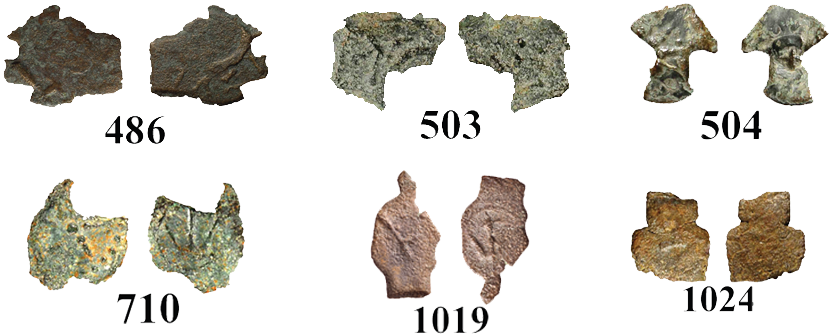
Fig. 13: Representative coins from Khirbet el-Maqatir struck on defective flans
Why these defective
flans were struck instead of being gathered, remelted, and cast
into ›normal‹ flans, is unknown. Maybe it was out of
indifference since the coins were mass produced, resulting in
little concern for quality control. The mint was given a certain
amount/weight of bronze to make coins and the money bag was
returned with the same weight of coins. The production of such
crude coins, struck on defective flans, and their use in
circulation might be another possible evidence that types
L-III–IV were struck after Jannaeus, as he would probably not
agree to the use of such coins, never seen before.
[1]
TJC, p. 210.
[2] The
Associates for Biblical Research excavated Khirbet
el-Maqatir from 1995–2000 and 2009–2016. Khirbet
el-Maqatir is located in the central hill country of
Judea 16 km north of Jerusalem (NIG: 213403 E / 605355
N). For the publication of the coins see Farhi
forthcoming.
[3]
Unless otherwise noted, all of the coin photos are by
Michael C. Luddeni. We wish to thank C. Corbin Kuhn for
formatting all of our figures.
[4] We
wish to thank David Hendin for permission to include
this coin in our study.
[5]
Larsen forthcoming.
[6]
TJC, p. 210, L1–L17.
[7] See
for example, Shachar 2004, p. 7; Ariel 2014, pp.
245–249, 251–254; Ariel 2016, p. 80; also Krupp (2011,
pp. 41–42)
finds it convenient to divide the small anchor/star
coins into two subgroups (his Types P and PB).
[8] The
metrology for all of the subgroups in the following
discussion was determined by using coins from Khirbet
el-Maqatir (cf. note 1). L-I:
18 coins; L-II:
149 coins; L-III:
491 coins; L-IV:
78 coins.
[9] We
wish to thank Ziv Zur, Israel, for permission to include
this coin in our study.
[10]
Reference Fig.10. For the coin in the private
collection, if the plain circle around the rays is
projected to a complete circle that surrounds the rays
and letters, then the image would be ~10mm in diameter.
For the TJC L coin, the rays are 4–5mm in
length; thus the radius of the star itself should be
10mm, with another 4–5mm for the circle and legends, the
star die would be ~15mm in diameter. Both coins have a
similar sized anchor. The size of a complete anchor is
~8mm. If another 8mm is added for a complete circle and
legend, then the anchor side would be ~16mm in diameter.
[11] Kindler 1967, p.
186.
[12] Hendin 2009, p.
107.
[13]
TJC, p. 71; Hendin 2009, p. 108.
[14] Hendin 2009, p.
113.
[15] Hendin 2009, p.
114.
[16] Hendin 2009, p.
117; GBC, p. 240–241, nos. 1185–1187.
[17]
Hendin 2009, p. 117; GBC, p. 245, no. 1197.
Contra Meshorer (TJC, p. 80 and 225, no.
72).
[18] In
the expanded discussion below, our proposal is not
suggesting that merchants and buyers in the ancient
markets were trying to count rays on these tiny, crudely
struck coins to distinguish their denominational value.
However, it would have been simple, as it is today, to
distinguish between L-I (and possibly L-II) in contrast
to L-III–IV, just by looking at the size and shape of
the flans.
[19]
Meshorer’s TJC group L1–3 coins are much
more scarce in excavations compared to other Alexander
Jannaeus coins. For example, at Khirbet el-Maqatir 18
coins of type L1–3 were found compared to 74 group K
coins and 720 L4–16 coins. A reasonable explanation for
this is that L1–3 coins were struck in a shorter period
(80/79–76 BCE at the maximum), while the other types had
much more time to appear.
[20]
Hendin 2009, p. 113.
[21]
Ideally, the question of when these coins were minted
could be answered if we could find and excavate a site
which was built and occupied during the reign of
Alexander Jannaeus and ceased being occupied prior to
Herod I. If such a site lacked L-III and L-IV coins,
then one could begin to build an argument for the
minting of these coins in the late first century BCE or
during the first half of the first century CE.
[22] See
also Krupp 2011, p. 42.
[23]
Rappaport 1984, p. 39; Syon 2014, p. 115; Syon 2015, pp.
45–47; Farhi 2016, p. 73; Larsen forthcoming.
[24] If
not after the Roman conquest of 64 BCE, certainly
after 6 CE, when, following the deposition of Herod
Archelaus Judea came under direct Roman rule, the
continued use of Alexander Jannaeus coins may have also
provided a not-so-subtle declaration against Roman rule
(for a more developed argument see Larsen forthcoming).
[25] Hill
1922, pp. 36–37.
[26]
BMC Palestine, pl. XXII:4.
[27]
Schindel 2014, p. 47. Woytek (2006, pl. 11.22) published
an image of a metal block (47x25mm) with two die
impressions cut into the metal (each impression is 17
and 15mm respectively).
[28] See,
for example Ariel 2012, p. 55 (Table 2), who list
several connected-flan molds, some with the ability to
make hundreds of flans at one time.
[29] The
coins in figure 13 will appear, with these numbers, in
Farhi forthcoming.